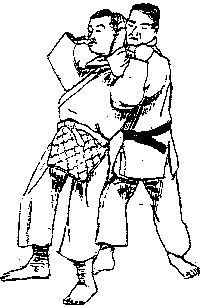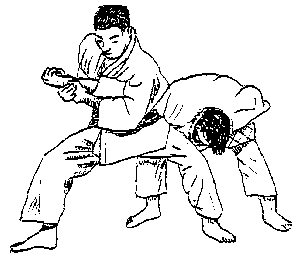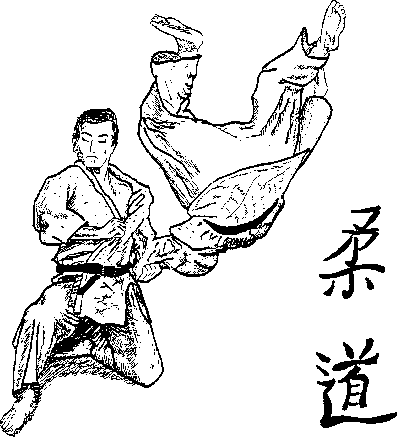The Philosophy of Judo | Judo Info (original) (raw)
 The subject should start with the word Judo itself because it means a gentle way. The interpretation of gentle (ju) and way (do) requires more understanding than the simple statement above allows.
The subject should start with the word Judo itself because it means a gentle way. The interpretation of gentle (ju) and way (do) requires more understanding than the simple statement above allows.
Judo is a dichotomy because it is both gentle and dynamic in activity. The sport uses the same concept borrowed from the ancient Japanese jujitsu where ju also meant gentle. In both systems it meant to not resist, to give way, to be compliant. It referred to conditions where someone imposes their will upon you. Usually this is a physical action, but it could be verbal as well.
The Judo response is to give way, to not meet force head-on. However this is for the purpose of defensively beating the oppressor. When the appropriate Judo-based action takes place it may not appear to be gentle. The action is a result of what happened, how it happened, and what the future implications will be.
The sport is a means of exercise that has meaning and significance to its practice. Each technique is a method that may apply to the situation of physical attack or how not to be injured when thrown to the ground. Since many of Judo’s finest sporting techniques result in body throws, it is essential that Judo students learn how to fall from every conceivable manner and direction. It basically takes about three months’ practice, but years to perfect. Once learned it is also applied to accidental falls during one’s lifetime. Thus in a matter of months a lifetime benefit may result.
The Judoist practices defensive and offensive (after an overt movement) techniques in a realistic manner because once they learn the falling art they may freely engage in seemingly violent actions. To a fellow judoist the actions are not violent, but to a lay person they appear that way. Also if done to an opponent on the street they can result in severe trauma.
The combative techniques of Judo have the most scientific analysis and application of methods of any martial art. The founder has taught that via his schools (Kodokan Judo Dojo) for about 120 years. He was already a top expert in two jujitsu schools when he culled and improved all techniques as the martial art methods for his new system and school of Judo (the Kodokan). His maxims for all students were “maximum efficiency” and “mutual benefit”.
By these rules he and his disciples have spent about 120 years perfecting the most effective and efficient self-defense system known. To be of mutual benefit he separated the sporting moves from the harmful self-defense system. As a student’s proficiency improved they gradually learn more significant techniques because their control has increased with their knowledge. They will not apply a technique to a fellow student that is beyond their safe capability. Safety is an important part of the training.
 Therefore Judo combines techniques of jujitsu, karate, wrestling and its own highly perfected techniques. It uses the hands, arms, body, legs, and feet to defeat an opponent. Judo techniques do not reject strength as long as it is efficiently applied in a highly controlled manner. The application of strength as used in Judo is multiplied in effectiveness to the point where a weaker exponent of Judo can best a larger and stronger opponent. Dr. Kano, when about 140 pounds, once fought a young Russian merchant seaman (Mark Bagello) who was undefeated even with an open $100 bet that he couldn’t be beaten. No one had been able to win the bet. Hearing of this brought to Dr. Kano’s mind that this might be a good test for his newly perfected self-defense system. The sailor was in the 240 pounds class and was happy to oblige him. After all Mark was six feet tall with a large frame and successfully had challenged any man in the world to fight him and had suffered no losses. During their fight he grabbed at the small Japanese expert, but he immediately found that no matter what he did he ended up on the ground. He tried, but nothing worked. He was embarrassed and later commented, “He was so small and I couldn’t lay a hand on him”. Try as he might it was like fighting air, but with harsh consequences. In worse condition than when he started and in frustration, he even try to hit Dr. Kano with a chair. This was quickly taken from him. Finally he stopped, realizing the futility of his efforts. Dr. Kano admired his tenacity in spite of his injuries and put his arms around him saying, “I love your spirit!” He also told him that if he wished to understand what defeated him, he would be very happy to personally teach him.
Therefore Judo combines techniques of jujitsu, karate, wrestling and its own highly perfected techniques. It uses the hands, arms, body, legs, and feet to defeat an opponent. Judo techniques do not reject strength as long as it is efficiently applied in a highly controlled manner. The application of strength as used in Judo is multiplied in effectiveness to the point where a weaker exponent of Judo can best a larger and stronger opponent. Dr. Kano, when about 140 pounds, once fought a young Russian merchant seaman (Mark Bagello) who was undefeated even with an open $100 bet that he couldn’t be beaten. No one had been able to win the bet. Hearing of this brought to Dr. Kano’s mind that this might be a good test for his newly perfected self-defense system. The sailor was in the 240 pounds class and was happy to oblige him. After all Mark was six feet tall with a large frame and successfully had challenged any man in the world to fight him and had suffered no losses. During their fight he grabbed at the small Japanese expert, but he immediately found that no matter what he did he ended up on the ground. He tried, but nothing worked. He was embarrassed and later commented, “He was so small and I couldn’t lay a hand on him”. Try as he might it was like fighting air, but with harsh consequences. In worse condition than when he started and in frustration, he even try to hit Dr. Kano with a chair. This was quickly taken from him. Finally he stopped, realizing the futility of his efforts. Dr. Kano admired his tenacity in spite of his injuries and put his arms around him saying, “I love your spirit!” He also told him that if he wished to understand what defeated him, he would be very happy to personally teach him.
This offer was accepted and in time the sailor became both an expert Judoist with a fourth degree black belt and a medical doctor. Dr. Bagello related this experience himself to a Judo friend (Bill Nauta, godan of the Encino Judo Club). Dr. Kano was among the very best Judoists and rightly held the highest black belt rank of tenth degree. Dr. Kano was also an Oxford scholar, president of Tokyo University of Education, and a noted world lecturer.
The purpose here is to discuss Judo philosophy, but it’s perfected physical results are also well worth remembering. The sport is practiced in most countries of the world and also in Olympic competition. The use of the original Japanese terminology and formal courtesies make it easy to practice in any Judo club in the world.
With the above perspective on the purpose and effectiveness of Judo sport and self-defense it is possible to examine how all this reflects in his philosophy. Dr. Kano meant for his gentle way to be a way to live, a path to follow. He chose a word (do) which translates as, a road or pathway. His self-imposed restriction, that he taught what can be a violent response to provocation as instead a controlled and limited response, certifies that he sought peace and harmony in life and between human beings.
Consider that you are a Judo expert and find your present company imposing, overbearing, and obnoxious. Suppose among them there is a physical altercation and a threat of fighting. You are a practiced specialist at this. A real expert. You know how badly people can be injured how simple it is for this to happen. You probably were active in Judo contests that same week. Would you find need and incentive thus to engage with amateurs? You do not have to prove yourself, and your philosophy is to minimize your reactions if you are somehow involved. You might even find yourself an amused bystander. You would not have incentive to either participate or incite such activities.
A time comes to mind where one such Judo expert in a restaurant found himself punched at by an unruly customer who didn’t like Japanese people. This Judo expert was a U.S. champion and easily dodged the blow while reacting automatically with a foot technique he often used on the Judo mat. However on the hard, slick, floor his opponent promptly hit the deck and slid along it some distance unconscious. The Judoist thought he had killed him. Assured otherwise, he sat back down with his companion Judoists and expressed amazement at his devastating results. “I had no idea an unskilled person would go so far.” He apologized in a tone that said he had overdone his response. Next time he would use a more moderate response to such a ruffian.
Thus the true Judoist needs prove nothing and pride themselves on the minimum response when forced to defensive actions. The assurance this creates to the ego does not make them belligerent, but rather very tolerant. They submit to more provocation and indignity than the average person who feels the need to save face and prove himself. This translates as self-assurance which frees the Judoist from peer pressure and encourages true self-expression. The directive of “maximum efficiency” in the use of your mental and physical energy when applied, means that your schoolwork or vocational efforts will be enhanced.
If you applied only “maximum efficiency” (seiryoku zenyo) to all in life it certainly would be efficient in a cold, calculating, way. Hardly a person for others to enjoy or with which they could relate. While you might not be selfish, the result of your efficiency would seem selfish. Therefore the philosophy of maximum efficiency, while highly productive, is by nature self-serving.
 The solution is one more directive from Dr. Kano which is “mutual benefit” (jita kyoei). This then requires that one act not just in one’s own interest, but rather with consideration for one’s fellow humans.
The solution is one more directive from Dr. Kano which is “mutual benefit” (jita kyoei). This then requires that one act not just in one’s own interest, but rather with consideration for one’s fellow humans.
The U.S. Constitution and Bill of Rights are famous for what they do not say as well as what they do say. By specifying a few general rules there is a leeway and flexibility that covers numerous unforeseen circumstances and contingencies. Dr. Kano’s principles translate into an advocacy to live a gentle life, in a very efficient manner, with thought and consideration for all. Thus he too has prescribed a simple premise to guide us in the great variety of life’s tasks and inter-relationships. Its value is its simplicity.
To emphasize that Dr. Kano meant for his students to use judgment, and control their responses and actions according to his principles, the following quotation is of value, “To become excited is a benefit to no one, but rather harmful to one’s self and others.” I have found that this is an important interpretation by him. During the occasional emergency situations I have faced I find these words running through my mind calling upon me to calmly act efficiently to solve the problem.
Many Judo students practice the sport without the philosophy. Many Judo students, come and participate for a while and then drop back into the mainstream with limited benefits. The student who stays with the sport gradually realizes the overall value and implications of the philosophy. This student is the one in a thousand to achieve the black belt rank and acts to teach his art and philosophy to the many other students. Dr. Kano’s gift to us of his magnificent sport and self-defense system, is no less a gift than that of the balance of his philosophy. The young sport enthusiast has an opportunity to meet life on Dr. Kano’s terms with the additional guidance of their life when they include the philosophy of Judo.